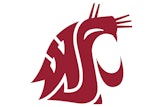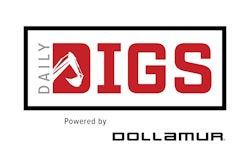
For the first time, the general public has an insider view of Augustana University's Midco Arena, the on-campus home of Augustana hockey in Sioux Falls, S.D.
When the puck drops in Midco Arena in mid-January 2024, it will seat 3,082 fans and include a luxury club area and 12 suites.  Courtesy of Augustana U. Athletics
Courtesy of Augustana U. Athletics
In addition to the 154,000 square-foot arena, and the amenities for the hockey program such as a locker room and puck shooting room, the facility will house the GreatLIFE Strength & Conditioning Center, a locker room and lounge area for the Viking soccer team.
The GreatLIFE Strength & Conditioning Center is over 4,400 square feet with a second-level turf area spanning more than 2,800 square feet. In all, Augustana’s strength & conditioning facility will total nearly 7,300 square feet.
As fans enter Midco Arena, they’ll be able to enter the SKOL SHOP, a one-stop shop to purchase their Augustana hockey and Augustana athletics apparel.
 Courtesy of Augustana U. Athletics
Courtesy of Augustana U. Athletics
“We’re officially under a year away from competing in our inaugural season, and with that comes a great amount of anticipation and excitement,” Vikings head coach Garrett Raboin said. “There’s a wow factor in what we’re building on 33rd and Grange and there are few things better than showing recruits and their families Midco Arena.” — Augustana Athletic Communications
Lincoln, Neb., is getting closer to having a new sports complex for young people.
The City Council recently approved up to $4.5 million in federal COVID-19 aid for the project.
The Lincoln Youth Complex will be built on the southeast side of North First Street and Cornhusker Highway, north of Oak Lake Park.
“It’s something that we don’t have; a lot of communities around us have these types of facilities. I think it’s going to draw people to the city of Lincoln through the Midwest,” said Dwight Merilatt, athletic director for Nebraska Wesleyan University and member of the complex’s board.
The 2015 Visioning Group is the nonprofit behind the operation of the Lincoln Youth Complex. It is the same nonprofit that developed the Pinnacle Bank Arena.
The complex will also be home to Nebraska Wesleyan’s baseball and softball programs. Wesleyan will also develop a program to work with underserved young people in Lincoln.
The complex will house two championship fields, five youth fields and an additional field for Homer’s Heroes, a special-needs baseball program.
The new complex will cost $27 million, with funds coming from the public and private sector.
Construction is set to begin this spring, with completion scheduled for late fall 2024.
Developers say the project will help Lincoln move forward and attract and retain families. — KLKN-TV
Spokane County (Wash.) and the Spokane Indians have agreed how to share the cost of their $23 million renovation to Avista Stadium, the county-owned facility that serves as the team’s home ballpark.
After a contentious and lengthy discussion, the Spokane County Commission recently narrowly approved a memorandum of understanding with the Indians that achieves two primary goals.
First, the agreement defines how much Spokane County and the Indians will pay for upgrading Avista Stadium. Second, it sets the terms of the Indians’ new lease, which will go into effect after the stadium improvements are complete.
Major League Baseball is raising the standard for minor league ballparks throughout the country, mainly for the sake of players.
Avista Stadium, which was built in 1958, needs a long list of upgrades before the 2025 season to comply with MLB’s new requirements.
Player improvements, such as new locker rooms, training facilities and dugouts, will cost $16.5 million. The county and Indians also are adding spectator amenities, including new field-level seats at the end of the dugouts.
For more than a year, the county and Indians have traded proposals for funding the renovation project. The fundamental question during negotiations has been straightforward: How much of the financial responsibility belongs to the stadium’s owner, and how much belongs to the stadium’s for-profit tenant?
Spokane County in December said it would contribute up to $8 million, provided the Indians could come up with $8 million in matching funds. Spokane Valley and the Indians have each pledged $2 million. The Indians are lobbying the Legislature for more than $5 million, and the county is hoping Sen. Patty Murray, Sen. Maria Cantwell and Rep. Cathy McMorris Rodgers can find federal funding, too.
The new memorandum of understanding not only states the county and Indians’ financial obligations for the renovation project, it also outlines the terms of the team’s new 20-year lease.
Starting after the improvements are made, the Indians’ rent will increase from $25,000 to $100,000 a year. The rent will go up by an additional $2,000 every year after that.
The Indians will assume all maintenance and operations expenses, which have cost the county about $150,000 annually.
Once the Avista Stadium renovation project is complete, the Indians will give the county a portion of their ticket sales. The team will give the county $1 for every ticket sold, with one major catch. The revenue sharing would only happen when the team surpasses 250,000 in annual attendance. If the team sold 300,000 tickets, the county would get $50,000.
The Indians drew 234,000 fans last year, but team president Chris Duff said he expects attendance to climb into the 275,000-300,000 range in the coming years. Duff noted that a cold, wet spring depressed fan turnout in 2022. On top of that, the Indians in 2022 became a long-season ballclub with 66 home games, compared to 38 in the past. Attendance will grow once fans adjust to the new schedule, Duff said. — The Spokesman Review
Take a look through and share these recent Facility Friday highlights:



































